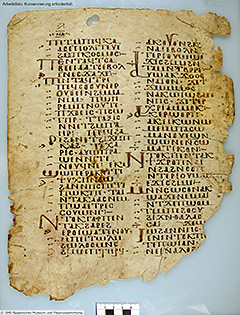|
Material: Pergament |
Acquisition: Antikenhandel Kairo |
|
Form: Kodex |
Location:
Papyrusdepot |
|
Text Layout: 2 Kolumnen; Zeilen: 33 |
Side and Direction:
|
|
Language: Koptisch |
Other Side:
|
|
Genre: literarisch |
Script and Notations: Schöne Buchschrift. Gleichmäßige Unziale mit regelmäßiger Zeilenführung; max. 10 Buchstaben pro Zeile. E, O, C schmal, aber O manchmal ganz rund; 3-Strich M; W und Shai eher eckig. Initialen und Djinkim vorhanden. I, T, P, Fai in den letzten Zeilen des Blattes verlängert nach unten.Logische Interpunktion (Mittelpunkte). Pricking sichtbar. Buchstabenhöhe: 0,5 cm; Zeilenabstand: 0,3 cm; Zeilenlänge: 7,4 cm |
|
Date: 10. – frühes 11. Jh. n.Chr. |
Provenance: Skriptorium von Tuton |
Content:
Bruchstück der sogenannten Metastasis Johannis. Nach einer anderen Handschrift veröffentlicht von Ignazio Guidi, und nach Brit.Mus.MS Oriental No.6782 von Wallis Budge; neuediert von Junod & Kaestli. Der Text auf P.8772 entspricht: Budge p.55, cap.9,1.2 - cap.11,1.7; Textanfang: ⲟⲩϣⲧⲏⲛ ⲛϩⲃⲱⲱⲥ ⲧⲉ ϩⲓⲱⲱϥ ⲙⲁⲩⲁⲁⲥ |
Publication:
J. Leipoldt, BKU I 182.
Additional Literature:
Beltz, Katalog I, S.110; Zur phys. Zugehörigkeit vgl. E. Lucchesi, Contribution codicologique au corpus copte des actes apocryphes des apôtres, in: P.-H. Poirier, La version copte de la Prédication et du Martyre de Thomas [Subsidia hagiographica 67], Bruxelles 1984, 15; Zum Text "Metastasis Johannis" vgl. I. Guidi, Rendiconti della R. Accademia dei Lincei. Classe di scienze morali, storiche e filologiche. vol. III, 74 f.; E. A. W. Budge, Coptic Apocrypha in the Dialect of Upper Egypt, London 1913, 51–58 (koptischer Text), 233–240 (englische Übersetzung); E. Junod, J.–D. Kaestli, Acta Iohannis. Praefatio, Textus alii, Commentarius. Indices 2 vols. [Corpus Christianorum. Series Apocryphorum, 1-2], Turnhout 1983, 376–397;
Alin Suciu, A Further Fragment from the Apocryphal Acts of John in Coptic: Once Again Concerning the Sotheby-Bolaffi Fragments; KOHD Coptica (Hasznos) |
Catalogs:
|
Notes:
Das Blatt ist im relativ guten Zustand mit klar lesbarer Schrift, Paginierung vorhanden: Haarseite: 43, Fleischseite: 44.
Stammt wahrscheinlich aus dem sog. Weißen Kloster und war Teil des Codex MONB.MQ. Vermutlich von derselben Hand wie die Osloer Handschrift, Museum of Cultural History, University of Oslo, inv. C47704 (H. Lundhaug, 'The Power of Michael Protected Him': A New Fragment of the Coptic Martyrdom of Apa Nahroou, CLARA 1, 2016) |
|
|





